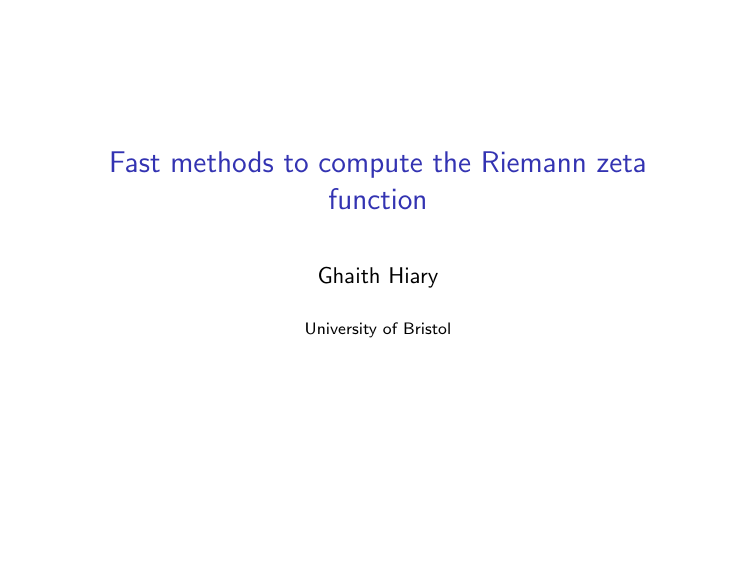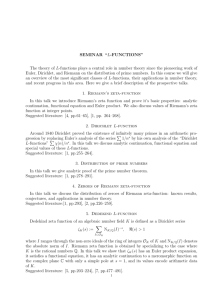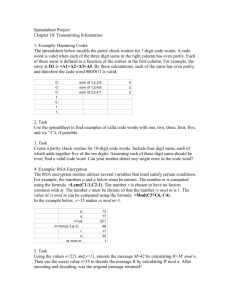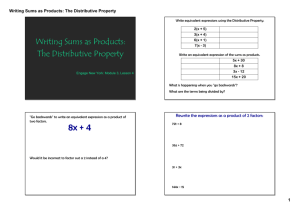Fast methods to compute the Riemann zeta function
advertisement

Fast methods to compute the Riemann zeta function Ghaith Hiary University of Bristol A general L-function An L-function can be represented as a Dirichlet series: L(s) := Y Lp (p −s )−1 = p ∞ X an n=1 ns , σ > 1. Define: Λ(s) := γ(s)L(s) , γ(s) := Q s/2 d Y Γ(s/2 + µj ) . j=1 For a certain choice of Q and µj , Λ(s) has: a meromorphic continuation with a finite number of poles (typically none), a functional equation: Λ(s) = ωΛ(1 − s). Approximate functional equation In computing L(s), with s = σ + it, using an approximate functional equation, the majority of the effort is exerted on the main sum: N X an n=1 n v (n, s) + ω s 1 N X an v2 (n, 1 − s) , n1−s N≈ q Q|t|d . n=1 By finding faster methods to compute the main sum, one obtains faster methods for L(s). Q. How fast can the main sum be computed? • Alternative approaches for computing L(s): shifted contour integral, explicit formula. Approximating L(s) by a single Dirichlet polynomial Appoximating zeta under the Lindelöf hypothesis: Let , δ > 0, then for σ = 1/2 + and N T δ , as T → ∞: L(σ + it) = X an (N) + N −+o(1) . ns n≤N A result of Bombieri and Friedlander: Let , 0 > 0, suppose for σ = 1/2 − and T ≤ t ≤ 2T , as T → ∞: L(σ + it) = X an (N) 0 + O(T − ) , s n n≤N then under certain natural conditions on L and an (N), we have N T d−o(1) , where d is the “degree”. Fast methods for the zeta function Theorem 1. (H.) For any λ, ζ(σ + it) can be computed to within ±|t|−λ in t 1/3+oλ (1) time. Theorem 2. (H.) For any λ, ζ(σ + it) can be computed to within ±|t|−λ in t 4/13+oλ (1) time. (Notice 4/13 ≈ 0.307). Also, a method for L(s, χ) with χ a character to a highly composite modulus. The t 1/3+oλ (1) method for ζ(σ + it) has been implemented (jointly with J.W. Bober). A survey and example applications A brief survey: Zeta: Euler-Maclaurin formula, Riemann-Siegel formula, Odlyzko, Schönhage, Turing, Heath-Brown, Rubinstein, Paris, Berry and Keating, ... Dirichlet L-functions: Davies, Deuring, Hejhal, Rumely, ... Higher degree L-function: approximate functional equation, Rubinstein, Booker, Dokchitser, Vishe ... Coefficients and eigenvalues: quadratic reciprocity, Schoof’s algorithm (and generalizations), Hejhal’s algorithm, ... Faster methods for L(s) can be used to numerically verify the Riemann hypothesis, compute values at special points, study empirical rate of growth of |L(1/2 + it)|, extreme behaviors of L(s), ... The Riemann-Siegel formula Riemann derived a formula for computing zeta. He used it to compute the first few complex zeta zeros. Formula was later (1932) found by Siegel in old notes of Riemann. On the critical line (σ = 1/2): ϑ(t) := arg π −it/2 Γ(1/4 + it/2) , Z (t) := e iϑ(t) ζ(1/2 + it) . Then Z (t) is real, |Z (t)| = |ζ(1/2 + it)|, and Z (t) = 2 X 1≤n≤ √ t/2π cos(t log n − ϑ(t)) √ + remainder terms . n Example 1: growth of |ζ(1/2 + it)| 10 Increasing maxima of zeta 8 ●● ● ● ● ● ● ● ● ● ● ●● ●● 6 ● 2 4 ● ● ●● ● ● ●● ●● ● ● ● ● ● ●● ●● ● ●● ● ● ● ● ● ●● ●● ● ● ● ● ● ● ● ● ● ● ● ● ● ● ● ● ● ● ● ● ● ●● ● ● ● ● ● ● 0 log( ζ(1 2 + it)) ● ●● ●● ● ● ●● 0 20 40 log(t) 60 80 Example 2: S(t) near a large value of zeta T3 =552166410009931288886808632346.50524 2 S(T + t) 1 0 1 2 32.0 1.5 1.0 0.5 0.0 t 0.5 1.0 1.5 2.0 Some generalities The basic idea: 1 Reduce to computing a large number of quadratic, or cubic, exponential sums. 2 Intervene to suitably normalizes the arguments of the quadratic, or cubic, sum. 3 Apply van der Corput iteration to obtain a shorter sum of a similar type, and compute the resulting remainder. 4 Repeat steps 2 and 3. The following computational model suffices: Compute: numerically eval. to within ±|t|−λ for any λ > 0. Complexity (time): # of required operations: +, −, ×, /. Arithmetic: log(2 + λ + |t|) bits ⇒ bit bound. Main sum for ζ(σ + it): reducing to exponential sums The main sum for ζ(σ + it) is X n−σ−it . 1≤nt 1/2 X The initial sum n−σ−it is evaluated directy. 1≤nt α The remaining sum is divided into “blocks”: X n −σ−it t α nt 1/2 So |Vt | t α log t. = +Kv X vX v ∈Vt n=v n−σ−it , Kv /v ≈ t −α . Main sum for ζ(σ + it): reducing to exponential sums vX +K n −σ−it =e −(σ+it) log v n=v K X e −(σ+it) log(1+k/v ) k=0 = J X j=0 wj Kj K X k j e 2πif (k) + J . k=0 total # of blocks t α log t. K /v t −α . the degree of f (x) is d1/αe − 1. 1/3 ≤ α < 1/2 1/4 ≤ α < 1/3 .. . f (x) is quadratic f (x) is cubic t 1/3 # blocks t 1/2 t 1/3 # blocks t 1/4 Want fast methods to compute such exponential sums. The quadratic case (α = 1/3): zeta in t 1/3+oλ (1) We can write the main sum as a linear combintation of t 1/3 log2 t quadratic (theta) sums: K 1 X j 2πiak+2πibk 2 k e F (K , j; a, b) := j , K k=0 The θ-algorithm: F (K , j; a, b) can be computed to within ± in (j + 1)2 log2 (K /) time. This yields zeta in t 1/3+oλ (1) . Classical: incomplete Gauss sums, partial theta sums Define F (K ; a, b) := PK k=0 e 2πiak+2πibk 2 . Partial theta sums studied extensively via Poisson summation. Special cases: F (K ; a, 0) is easy → Geometric Sum. If bK 1 → use Euler-Maclaurin summation. If F (K ; m/K , n/K ) → complete Gauss sum. Remark: Quadratic reciprocity implies that F (K ; a, b) is computable in poly-log time for (a, b) = (m/K , n/K ). The θ-algorithm implies F (K ; a, b) is still computable in poly-log time for any a, b ∈ [0, 1). The basic iteration: the case j = 0 c1 F (K ; a, b) = √ F b a 1 ba + 2bK c; , − + R. 2b 4b Intervention: F (K ; a, b) = F (K ; a ± 1; b) = F (K ; a, b ± 1) = F (K ; a ± 1/2, b ± 1/2) . ⇒ can ensure b ∈ [0, 1/4] ⇒ 2bK ≤ K /2. So with each iteration the length decreases by at least 1/2. Computing the remainder: no saddle-points, Cauchy’s theorem, stationary phase, exponential decline, truncate after distance log(K /), reduce to a simple type of incomplete Gamma function. This is the time consuming part. Numerical behavior of the θ-algorithm 9 1e8 θ-algorithm timings near T =7 ×1031 Terms per second 8 7 6 5 4 3 2 1 00.0 0.5 1.0 1.5 v 2.0 2.5 3.0 3.5 1e15 Zeta algorithm timings Running time compared to t1/3 (logt)2.5 growth 5 Relative cputime 4 3 2 1 00 1 2 3 4 t 5 6 7 8 1e31 Faster methods: the cubic sums algorithm H(K , j; a, b, c) := 1 Kj PK k=0 k j e 2πiak+2πibk 2 +2πick 3 Still have periodicity, but not self-similarity.. Special cases: If bK 1 and cK 2 1 → Euler-Maclaurin summation. If cK 3 1 → θ-algorithm. Cubic sums algorithm. Given µ ≤ 1, then for any 0 ≤ c ≤ K µ−3 : the cubic sum H(K , j; a, b, c) can be computed to within ± in (j + 1)5 log5 (K /) time, provided a one-time precomputation costing (j + 1)5 log5 (K /)K 4µ time is performed via the FFT. The key observation is the precomputation costs ≈ K 4µ time. A heuristic device: the case j = 0, a = 0 van der Corput iteration f 0 (x) strictly increasing in 0 ≤ x ≤ K , and xm is defined by f 0 (xm ) = m for f 0 (0) < m < f 0 (k): X e 2πif (k) = c1 0<k<K Consider PK k=0 e e 2πi(f (xm )−mxm ) p + R. |f 00 (xm )| f 0 (0)<m<f 0 (k) X 2πibk 2 +2πick 3 . For m ∈ (0, 2bK + 3cK 2 ), we have: 2b 3 + 9bcm − 2 b 2 + 3cm f (xm ) − mxm = 27c 3 This is not a cubic... but what if c is small? 3/2 . “Approximate self-similarity” Assuming cK 2 1, and bK ≥ 1, then c 1 f (xm ) − mxm = − m2 + 3 m3 + O 4b 8b c 2K 4 b . If c 2 K 4 /b 1 ⇒ can make new sum cubic. Thus, the van der Corput iteration suggests: K terms → 2bK + 3cK 2 = 2bK + O(1) terms. 2 4 1 bk 2 + ck 3 → − 4b m2 + 8bc 3 m3 + O c bK . Can ensure b ∈ [0, 1/4], so length decreases by a factor of ≤ 1/2. But also, since c → c/(8b 3 ) ≥ 8c, the cubic coeff. c grows. Character sums Let χ be a Dirichlet character mod q. Define: S(K , χ) := PK k=1 χ(k) Q. How fast can S(K , χ) be computed? A.G. Postnikov, 1955 χ primitive mod p a (p odd) ⇒ χ(1 + kp b ) ≡ e 2πif (k) , f (x) ∈ Q[x]. Lemma 1. χ mod p a (p odd), b := da/3e, then 2πiLk 2 4πiLk b + a−2b , χ(1 + p k) ≡ exp p a−b p and L can be determined in O(log p) time. Twisted quadratic sums and L(s, χ) Using lemma 1, we can write: X S(K , χ) = χ(r )F (K /p da/3e ; ar , br ) . 0<r <p da/3e gcd(r , p) = 1 Via the θ-algorithm, S(K , χ) can be computed in ≈ p da/3e steps. Example. q = p 3 , χ mod q ⇒ S(K , χ) in pq = q 1/3+ steps. Example. q = p a , χ mod q ⇒ improves on q 1/2 unless a = 1, 2, 4. Let q = p1a1 p2a2 . . . phah (p’s odd), and χ be a character mod q ⇒ da /3e da /3e da /3e S(K , χ) is computable in p1 1 p2 2 . . . ph h q steps. P j 2πiak+2πibk 2 . Gives The approach generalizes to K k=1 (k/K ) χ(k)e L(s, χ) in better than q 1/2 t 1/2 , best case q 1/3 t 1/3 .








